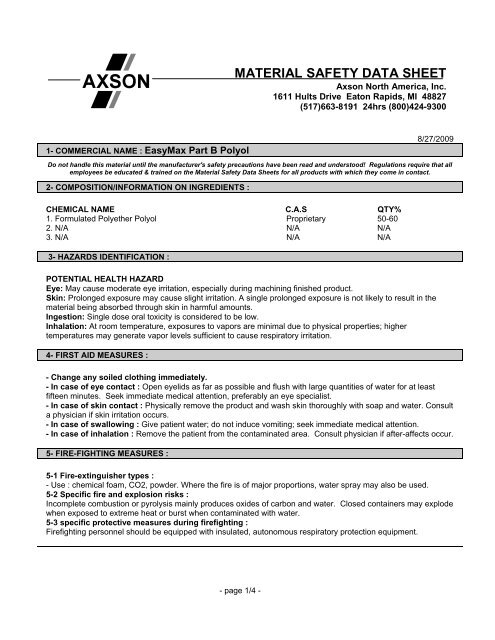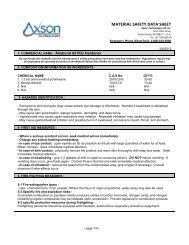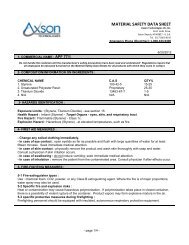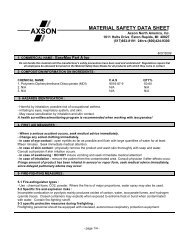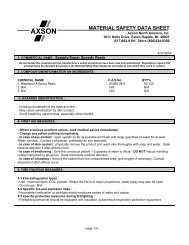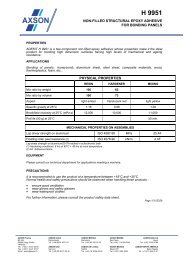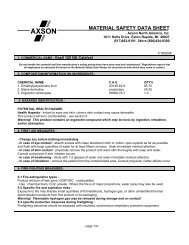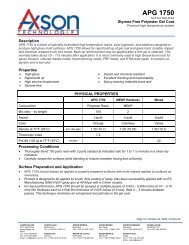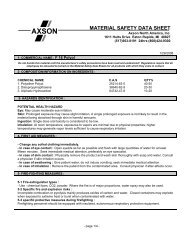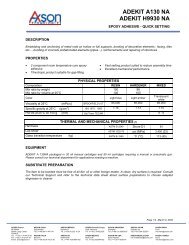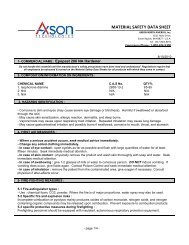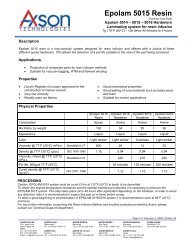Polyol MSDS - Axson North America, Inc
Polyol MSDS - Axson North America, Inc
Polyol MSDS - Axson North America, Inc
Create successful ePaper yourself
Turn your PDF publications into a flip-book with our unique Google optimized e-Paper software.
MATERIAL SAFETY DATA SHEET<strong>Axson</strong> <strong>North</strong> <strong>America</strong>, <strong>Inc</strong>.1611 Hults Drive Eaton Rapids, MI 48827(517)663-8191 24hrs (800)424-93001- COMMERCIAL NAME : EasyMax Part B <strong>Polyol</strong>8/27/2009Do not handle this material until the manufacturer's safety precautions have been read and understood! Regulations require that allemployees be educated & trained on the Material Safety Data Sheets for all products with which they come in contact.2- COMPOSITION/INFORMATION ON INGREDIENTS :CHEMICAL NAME C.A.S QTY%1. Formulated Polyether <strong>Polyol</strong> Proprietary 50-602. N/A N/A N/A3. N/A N/A N/A3- HAZARDS IDENTIFICATION :POTENTIAL HEALTH HAZARDEye: May cause moderate eye irritation, especially during machining finished product.Skin: Prolonged exposure may cause slight irritation. A single prolonged exposure is not likely to result in thematerial being absorbed through skin in harmful amounts.Ingestion: Single dose oral toxicity is considered to be low.Inhalation: At room temperature, exposures to vapors are minimal due to physical properties; highertemperatures may generate vapor levels sufficient to cause respiratory irritation.4- FIRST AID MEASURES :- Change any soiled clothing immediately.- In case of eye contact : Open eyelids as far as possible and flush with large quantities of water for at leastfifteen minutes. Seek immediate medical attention, preferably an eye specialist.- In case of skin contact : Physically remove the product and wash skin thoroughly with soap and water. Consulta physician if skin irritation occurs.- In case of swallowing : Give patient water; do not induce vomiting; seek immediate medical attention.- In case of inhalation : Remove the patient from the contaminated area. Consult physician if after-affects occur.5- FIRE-FIGHTING MEASURES :5-1 Fire-extinguisher types :- Use : chemical foam, CO2, powder. Where the fire is of major proportions, water spray may also be used.5-2 Specific fire and explosion risks :<strong>Inc</strong>omplete combustion or pyrolysis mainly produces oxides of carbon and water. Closed containers may explodewhen exposed to extreme heat or burst when contaminated with water.5-3 specific protective measures during firefighting :Firefighting personnel should be equipped with insulated, autonomous respiratory protection equipment.- page 1/4 -
COMMERCIAL NAME : EasyMax Part B <strong>Polyol</strong>8/27/20096- ACCIDENTAL RELEASE MEASURES :6-1 Individual protection :Wearing of suitable protective clothing and protective equipment for face/eyes.6-2 Environmental protection : Please see § 126-3 Decontamination procedures :- Contain spilt material in order to avoid its transfer to sewers or rivers and streams.- Physically remove the material.- Cover with an absorbent substance and remove for proper disposal.7- HANDLING AND STORAGE :7-1 Handling :- Inform personnel of risks associated with the product, the precautions to be taken and procedures to followwhere an accident occurs.- Observe personal hygiene rules to avoid contact with eyes and skin.- Avoid inhaling vapors produced by the material, especially when heated and/or sprayed.- Install showers and eye baths ("fountain" type).- Ensure sufficient ventilation, including appropriate local air extraction, in order to comply with workplaceexposure limits. Avoid dusts created during machining.- Wash hands thoroughly at beginning of every work break and at the end of the working day.- Work stations and the general working area must be kept perfectly clean.7-2 Storage :- Keep the material hermetically sealed in its original packaging, protected from humidity and at a temperaturebetween 59 and 77°F / 15 and 25°C in a well-ventilated storage facility.- Ensure that the floor of the storage area is impermeable and concave in profile in order to provide effectivecontainment.- Keep the product away from food.- Reproduce labeling on all new packs where original packaging is divided.8- EXPOSURE CONTROLS/PERSONAL PROTECTION :8-1 Exposure controls : Good general ventilation should be sufficient for most conditions. Local exhaustventilation may be necessary for some operations. Always maintain workplace air contaminates to a minimum.8-2 Personal protection :- respiratory protection : for most conditions, not necessary- eye protection : YES, safety glasses with side shields or goggles- skin protection : YES, protective gloves, such as nitrile, latex or rubber- page 2/4 -
COMMERCIAL NAME : EasyMax Part B <strong>Polyol</strong>8/27/20099- PHYSICAL AND CHEMICAL PROPERTIES :Physical state : pasteColor : various colorsOdor : lowpH : not establishedFlash point : > 230°F / 110°CDecomposition temperature : > 392°F / 200°CSpecific gravity : 0.69Solubility : - in water : at 68°F / 20°C : slight- in solvents : YES (soluble in many organic solvents : benzene hydrocarbons andchlorinated hydrocarbons, acetone, phthalates, ...)10- STABILITY AND REACTIVITY :10-1 Dangerous decomposition by-products :- These are non-existent if storage and handling rules are followed (please see also § 5-2).10-2 Hazardous reactions with :- Oxidizers. Avoid contact with strong acids; avoid unintended contact with isocyanates. Avoid moisture.11- TOXICOLOGICAL INFORMATION :Effects on eyes : may cause slight temporary irritation.Effects on skin : repeated or prolonged single exposure may cause irritation to the skin. May cause a cutaneousallergic reaction in predisposed individuals. It appears unlikely that any danger is attached to absorption ofquantities of the product through the skin following prolonged single exposure. LD50 (rabbit): >5,000 mg/kgEffects of inhalation : may be irritating to the respiratory tract; otherwise no foreseeable harmful effects.Effects on ingestion : harmful if swallowed. Low toxicity for a single oral dose. LD50 (rat): >2,000 mg/kg12- ECOLOGICAL INFORMATION :Based on data for one or more similar products :Ecotoxicity : this product has low toxic effect on fish in static acute conditions.Biodegradability : this product's biodegradability is low in static aerobic laboratory conditions.13- DISPOSAL CONSIDERATIONS :All disposal methods must be in compliance with all Federal, State/Provincial and local regulations. Regulationsmay very in different locations. Waste characteristics and compliance with applicable laws are the responsibilitysolely of the waste generator.For unused & uncontaminated product, the preferred options include sending to a licensed, permitted: recycler,reclaimer, incinerator or other thermal destruction device.- page 3/4 -
COMMERCIAL NAME : EasyMax Part B <strong>Polyol</strong>8/27/200914- TRANSPORT INFORMATION :DOT Regulations/Information:Proper Shipping Name: Not RegulatedHazard Class: N/AUN/NA Number: N/APackaging Group: N/AInternal label: H000200015- REGULATORY INFORMATION :US Federal RegulationToxic Substances Control Act (TSCA):All components are included in the EPA Toxic Substances Control Act Chemical Substance Inventory.OSHA Hazard Communication Standard hazard classes:Non-hazardous under the criteria of the Federal OSHA Hazard Communication Standard 29 CFR 1910.1200.OSHA PEL/TWA : noneSec. 313 Chemicals : none16- OTHER INFORMATION :HMIS Ratings:Health. Flammability. Reactivity2.1.1Ratings Key: 4 = Highest hazard, 0 = Lowest hazard, * = Chronic Health HazardREVEALING MODIFICATION : P1.PDFRevised : 8/27/2009 Supersedes sheet : 10/18/2002 This sheet provides a complement to the product use instructions but does not replacethem. The information it contains is based on our current knowledge of the product concerned at the date of drafting. That information is givenin good faith and does not in any circumstances remove from the user his duty to be aware of and to follow all legal regulations and statutescovering his activities. The user takes sole responsibility for application of safety measures covering the use of the product he is aware of. Wealso draw the user's attention to the risks attached to any use of the product for applications for which it was not designed. 03/2006- page 4/4 -


